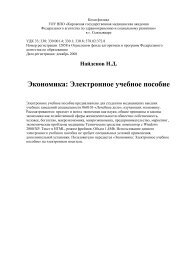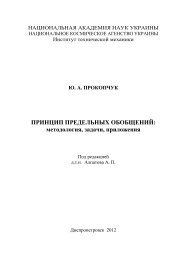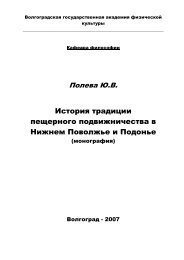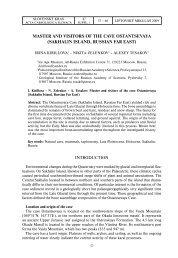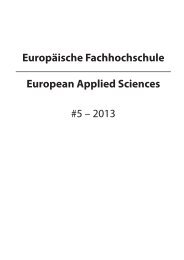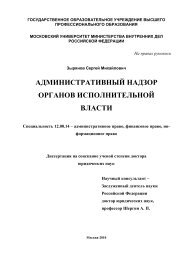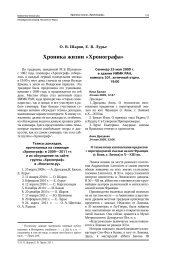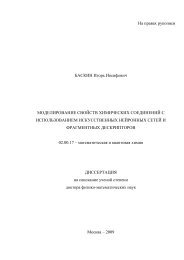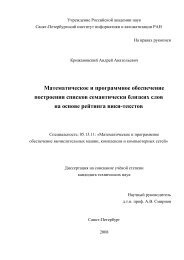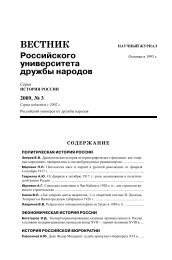Influence of Coulomb scattering of electrons and holes between ...
Influence of Coulomb scattering of electrons and holes between ...
Influence of Coulomb scattering of electrons and holes between ...
You also want an ePaper? Increase the reach of your titles
YUMPU automatically turns print PDFs into web optimized ePapers that Google loves.
144ARTICLE IN PRESSS.A. Moskalenko et al. / Physica E 39 (2007) 137–149on the ground state wave function Eq. (27) equals zeroeven for the term proportional to v 4 . Its contribution isnon-zero only in higher orders <strong>of</strong> the perturbation theory,when the coherent excited states were used, as it wasdemonstrated in the Ref. [27], where the correlation energycontain a factor v 4 u 4 . The role <strong>of</strong> smallness parameter isplayed by the filling factor v 2 ¼ 2pl 2 n ex o1. At a givenmagnetic field v 2 can be altered arbitrary within intervalð0; 1Þ by changing the exciton concentration n ex , or the totalnumber <strong>of</strong> excitons in the system N ex . Contrary to thesmall parameter r ¼ I l =_o c discussed above <strong>and</strong> relatedwith the intensity <strong>of</strong> the magnetic field there exists anotherindependent parameter n ex <strong>of</strong> different origin, which in ourconsideration must be small as compared to 1=2pl 2 .The quadratic Hamiltonian H 2 is given below for thecase <strong>of</strong> <strong>electrons</strong> <strong>and</strong> <strong>holes</strong> with equal masses m e ¼ m h ,cyclotron frequencies o ce ¼ o ch ¼ o c <strong>and</strong> chemical potentialsm e ¼ m h ¼ m=2:H 2 ¼ X ½Eðk; v 2 ; mÞþðB 2AÞv 2 ð1 2v 2 Þpþ 2v 2 ð1 v 2 ÞDðkÞŠða y p a p þ b y p b pÞþ X uv k xp b2kx pa p þ uv ppk x2a y p by k xf cðk; v 2 ; mÞþ2v 2 ðB 2A þ DðkÞÞ DðkÞg. ð32ÞFollowing the notations <strong>of</strong> Eqs. (40) <strong>and</strong> (41) <strong>of</strong> Ref. [27]we haveEðk; v 2 ; mÞ ¼2v 2 u 2 I ex ðkÞþI l ðv 4 v 2 u 2 Þm2 ðu2 v 2 Þ,cðk; v 2 ; mÞ ¼2v 2 I l þ I ex ðkÞð1 2v 2 Þþm, ð33Þwhereas the coefficients DðkÞ, A <strong>and</strong> B are determined byEqs. (17), (21) <strong>and</strong> (24), respectively. Putting to zero thelast bracket in Eq. (32), i.e. compensating the dangerousdiagrams describing the spontaneous creation <strong>and</strong> annihilation<strong>of</strong> e–h pairs in the vacuum state Eq. (27), one canobtain the chemical potential m <strong>of</strong> the system in the HFBA:m HFB ¼ ~I ex ðkÞþ2v 2 ðB 2A þ ~I ex ðkÞ I l Þ¼ ~I ex ðkÞþ2v 2 ðB 2A þ DðkÞ EðkÞÞ. ð34ÞHere the renormalized ionization potential <strong>of</strong> magnetoexcitons~I ex ðkÞ containing the correction due to influence <strong>of</strong>all ELLs was introduced:~I ex ðkÞ ¼I ex ðkÞþDðkÞ; I ex ðkÞ ¼I l EðkÞ,E ex ðkÞ ¼ I ex ðkÞ. ð35ÞIntroducing the value m HFB in the remainder part <strong>of</strong> thefirst line <strong>of</strong> Eq. (32), Hamiltonian H 2 will take the formH 2 ¼ X p~I ex ðkÞða þ p2a p þ b þ p b pÞ. (36)This Hamiltonian describes the single-particle elementaryexcitations from a single-exciton state with wave vector k<strong>of</strong> the condensed magnetoexcitons. To extract from thecondensate one pair <strong>of</strong> new quasiparticles the energy costp~I ex ðkÞ is equivalent to unbinding energy, i.e. the excitationenergy for one quasiparticle equals to ~I ex ðkÞ=2. Notice thatthe chemical potential m HFB in the point v 2 ¼ 0 coincides onthe energy scale with the position <strong>of</strong> the renormalizedmagnetoexciton energy b<strong>and</strong>~E ex ðkÞ ¼ ~I ex ðkÞ,while in the point 2v 2 ¼ 1 it equals to the value I l þ B2A <strong>and</strong> does not depend on k. The concentrationcorrections to m HFB are determined by the term2v 2 ðB 2A þ DðkÞ EðkÞÞ. (37)The term EðkÞ appears in the frame <strong>of</strong> the LLLs <strong>and</strong> wasobtained in the Refs. [26,27]. It determines the instability <strong>of</strong>the ground state within the HFBA, when the correctionsdue to ELL are neglected. The term B 2A appears inboth phases, not only in the case <strong>of</strong> BEC <strong>of</strong> magnetoexciton,but also in the case <strong>of</strong> EHL. The term 2A is relatedwith the average Hartree terms <strong>of</strong> the supplementary e–e,h–h <strong>and</strong> e–h interactions, whereas the term B with theaverage exchange terms <strong>of</strong> the supplementary e–e <strong>and</strong> h–hinteractions. The term 2v 2 DðkÞ is according to e–hinteraction <strong>and</strong> Bogoliubov u-v transformation <strong>and</strong> isnamed as Bogoliubov self-energy term [41]. As it will beshown below it does not appear in the case <strong>of</strong> EHL.The renormalized ionization potential in a dimensionlessform is represented in Fig. 1, when the parameter r wastaken equal to 1 <strong>and</strong> 1 2. Note the value 1 is the maximalpossible value because the theory is valid only for ro1. Theresulting influence <strong>of</strong> the ELLs on the chemical potentialmðk; v 2 Þ calculated in the HFBA is determined by thecoefficient ðB 2A þ DðkÞÞ as was mentioned above. In thedimensionless form it is represented in Fig. 2 also for twodifferent ratios r ¼ 0:5: 1. This influence, as well as theinfluence <strong>of</strong> FELLs discussed in the paper [28], is essentialonly in the range <strong>of</strong> small values <strong>of</strong> klo0:5, decreasingrapidly with the increasing <strong>of</strong> kl. The inset on this figurerepresents the coefficient ½B 2A þ DðkÞ EðkÞŠ, whichreflects the influence <strong>of</strong> both the LLLs <strong>and</strong> <strong>of</strong> the ELLs.Thus, the main result obtained so far, namely thedependence <strong>of</strong> the chemical potential m HFB in HFBAversus the filling factor v 2 <strong>of</strong> the LLL at different values <strong>of</strong>the dimensionless wave vector kl ¼ 0; 0:5; 1:0; 3:6 <strong>and</strong> fortwo different values <strong>of</strong> ratio r ¼ 0:5: 1 is presented in Fig. 3.One can see that the BEC <strong>of</strong> 2D magnetoexcitons withwave vector klo0:5 is stable in HFBA. As was realized inRef. [27,28] at greater values kl40:5 the influence <strong>of</strong>coherent excited states [37] is important <strong>and</strong> leads to theappearance <strong>of</strong> the metastable dielectric liquid phase.Now we consider the EHL formation in HFA. We startwith an effective Hamiltonian (13), but without chemicalpotentials m e <strong>and</strong> m h , <strong>and</strong> calculate the ground state energyE EHL <strong>of</strong> EHL at T ¼ 0 when the average values <strong>of</strong><strong>electrons</strong> <strong>and</strong> <strong>holes</strong> numbers on the LLLs are equal toha y p a pi¼hb y p b pi¼v 2 . (38)



